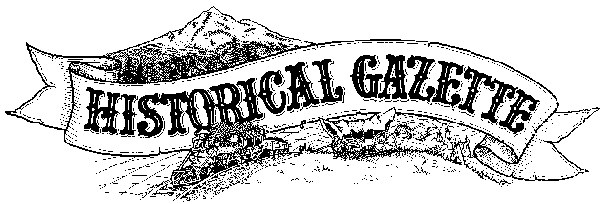History, mining and the Old West: my favorite interests led me to explore the backroads and mining districts of the Blue Mountains in Eastern Oregon. 
Editor's Introduction Waldemar Lindgren of the U.S. Geological Survey I collected a few maps and at first visited the well-known ghost towns and mining camps. I would try to visualize these old camps and all their activity. But I wanted more information on the lesser known areas. I could see old tunnels and piles of waste rock not mentioned on my maps and the well-known areas were too well-known.
I had an old book that listed a geologist of the name of Lindgren who had visited the Blue Mountains in 1900. His report "The Gold Belt of the Blue Moutains of Oregon" was sent back to the U.S. Geological Survey after his survey in August through December 1900. After mining the library, I found his report and it was everything I wanted and more. I packed my truck with camping supplies and Lindgren's report. Off I went to the "gold belt" (again and again) with my new found information.
Now I could go to an interesting area, know the name of the mining district I was in, the name of the mine, and know what the vein material looked like, how much gold was in the ore, the bonanzas, how many feet of development, shafts, levels and so on in 1900. This turn of the century report really made my visits so much more enjoyable. I collected some nice minerals, panned a little gold, and I spent some time thinking about sll the old fellas who were here before me, and that I was standing on the very spot, geologist Lindgren had stood, 95 years ago.
Professor Lindgren as he became known in later life (he taught at MIT} gave me a wonderful perspective about the Blue Mountains. I believe he was the first to decipher the geologic history of the great out-pouring of lava in this region. When you or I travel to Baker City and look around, we see the beautiful Blue Mountains and off to the Northeast, the Wallowa (Eagle Creek} Mountains. Quoting from geologist Waldemar Lindgren when he veiwed the same area:
That the pre-Neocene rivers had excavated their channels to a greater depth than the present streams is certain, that the lavas descended to the level of Snake River below Huntington, and that mighty stream flows for many miles on a basaltic bed. Take away the lava flows which covered the flanks of the Blue mountains, and you would see rising to imposing heights almost from sea level and separated by a lower gap, too great, roughly circular moutain groups - the Eagle Creek Mountains and the Blue Mountains proper.
Then, as now, the Blue Moutains were seamed by gold and silver veins, and the gold-bearing gravels accumulated in its valleys. The formation of the veins followed the great intrusions of granitic rocks.
Such were the conditions when the great neocene lava flows began to pour out from numberless fissures on the flank of the mountains. At first came rhyolites and andesites, then basalts in increasing volume. Lava streams covered each other in endless succession. The lower water courses became filled with basalts, daming the headwaters and creating the lakes. The sharp slopes became sloping plateaus, and finally the Blue mountains stood like islands in a basaltic sea. A salient of the Idaho mass, separated from it by the black surface of slowly cooling flows.
Reading that description made me see these mountains differently than before. After my visits to Eastern Oregon, I wanted to know something more about Waldemar Lindgren. It's interesting what I found out. So, I thought I'd share with you a short biography of Waldemar Lindgren. You can imagine: For more than nine years of geological field work he traveled by steam train, stagecoach, buck-board wagon and by foot. He was a prolific writer, much of which was written by candle light and kerosene lamp.
I'll be adding more of his reports as often as possible. If you would like to comment, send email to the editor at histgaz@gmail.com. We're interested in hearing from you especially if you've been to Eastern Oregon, the Wallowas, the Blues, or if you know of Prof. Lindgren and his trips to the many other gold camps in the West. These stories are available to our electronic readers as part of our contribution to the information available on the Internet. ~ Keith Whittle, editor
Read our other gold mining editions:
[Sumpter, Oregon 1900 | Gold Seekers Rush to California]
[ Oregon: Land of Gold & Opportunity | Dequille Reports from the Comstock]

Bridget E. Smith, editor & publisher
Short Biography of Waldemar Lindgren | "Gold Belt of Eastern Oregon"
Email | Home Page | Historic Headlines
Historical Gazette
Published in Portland, Oregon
© 1991-

